
 Americans have never had the same feelings about personal space as other cultures. Italians and many Europeans believe if you don’t provide a kiss on the cheek in your greeting it’s an offense. Now all around the world, there’s social distancing.
Americans have never had the same feelings about personal space as other cultures. Italians and many Europeans believe if you don’t provide a kiss on the cheek in your greeting it’s an offense. Now all around the world, there’s social distancing.
We are huggers though. The hugs vary by generation for sure and differ when addressing the same sex. Younger men have made the “shake and chest pump side hug” popular when greeting each other. Women seem to prefer the “gentle loose hug and pat the back” method.
No matter the intensity of the greeting, all bets are off after COVID-19 and the new norm of social distancing.
The new normal after COVID-19
Our current behaviors will be changed following this current episode. We just don’t know exactly how, and for how long.
No matter how we are used to greeting each other, that method will now likely be changed forever. Likewise, we are seeing that waiting in line has been changed to accommodate social distancing. Be prepared for longer lines with 6-foot gaps between people.
How do we manage this new normal within the marketing environment? What are the new rules that marketers will need to follow? In communication? In merchandising? At events?
Things to consider while creating new rules
 We will have to create new rules for social distancing. But how do we create new business rules limiting behavior while also keeping the user experience positive?
We will have to create new rules for social distancing. But how do we create new business rules limiting behavior while also keeping the user experience positive?
In today’s day and age, how do we let the consumer define the experience?
What is appropriate for some may be inappropriate for others. Everybody wants to personalize their experience. Is that doable?
Sneeze guards or masks for face to face meetings?
Think about face to face meetings and social distancing. How about the server at the McDonald’s counter? Can you really stay 6 feet away from your real estate agent or financial adviser?
Will your server at the restaurant need to wear a mask and gloves when delivering food? Will you need to wear gloves and a mask when going to a meeting? Possibly.
Some retailers have already started installing “sneeze guards” at checkout to keep their staff safe from customer infection. Back in the 1980s the health departments mandated the salad bar restaurants install sneeze guards. The guards are still in place. Will we create mobile personal sneeze guards that can be set up for a meeting? Someone will be responsible for cleaning and sanitizing the meeting sneeze guards after each meeting. They may become the norm.
Will every business need to maintain a supply of face masks in case a customer demands one? Probably. I can see a branded face mask available just like we have logoed coffee cups, pens and notepads.
Crowd control for the retail and event experience
Some companies (like Westamerica) are already producing vinyl floor graphics that help to direct traffic and create some “rules of the road” for those shopping or waiting in line.
These graphics can be highly customized and even light-hearted, but they all are focused on the goal of creating order amid the new consumer expectations of social distancing.
There are a lot of new behaviors that will be instituted during and after this COVID-19 episode. The alert marketer will keep a keen eye on the consumer sentiment, changing consumer behaviors and an awareness of the tools, technologies and techniques to keep the process flowing effectively.
Keep your eyes on this…but remember your “social distancing”.


 Wide-format printing is an excellent way to stand out in today’s crowded marketing environment at trade shows and other events. We like to say that large format printing technology makes “your big ideas even bigger.” When you couple the medium with a compelling graphic and prime location, using large format printing technology for trade show booth graphics and other special events grabs the attention of your intended audience.
Wide-format printing is an excellent way to stand out in today’s crowded marketing environment at trade shows and other events. We like to say that large format printing technology makes “your big ideas even bigger.” When you couple the medium with a compelling graphic and prime location, using large format printing technology for trade show booth graphics and other special events grabs the attention of your intended audience.